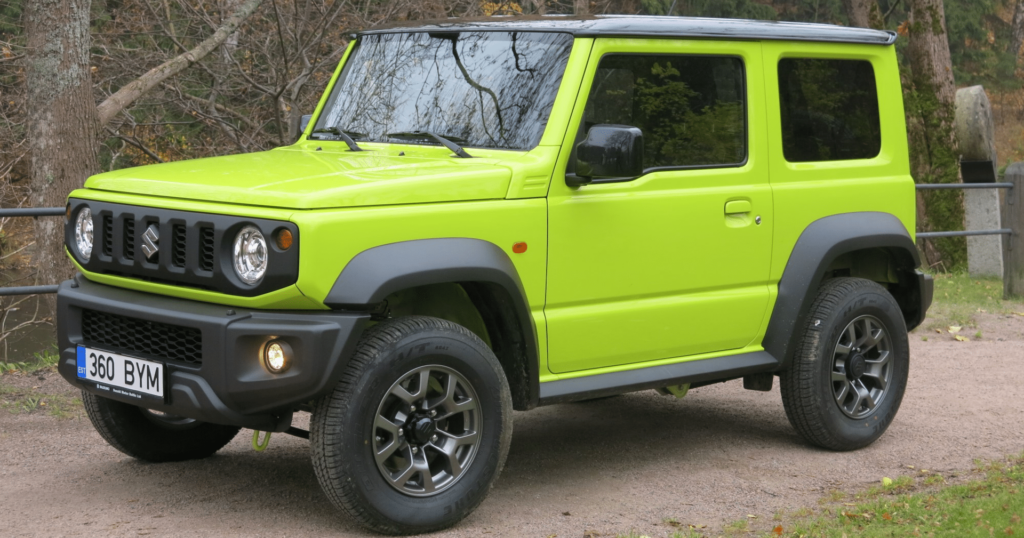Suzuki’s traditional SUV Jimny has now arrived in Finland.
The first Jimny was introduced back in 1970 and this is only the fourth generation of the model.
The first generation was on sale for 11 years, the second for 17 years and the third for 20 years. One might wonder whether this Jimny will still be on sale at the end of the 2030s
The new model was presented to the Finnish press last week, and the model attracted well-deserved attention: the Jimny is a very different car.
A thoroughbred SUV
It’s a thoroughbred SUV with a separate ladder-type chassis. It also has a reduction gearbox, so you can drive it very slowly off-road.
The seat and steering wheel are adjustable enough and the instrumentation is clear. There’s a screen in the centre of the dashboard, where you can access the navigation system, among other things.
The car is surprisingly lively and accelerates well enough. The test car had a manual gearbox and it worked precisely.
The car’s suspension and damping is quite hard, but not distractingly so even on a bumpy road.
Unfortunately, during the short presentation there was no opportunity to test the car off-road, but otherwise the car impressed with its dexterity.
On the road, the car is surprisingly quiet. However, the tyres were on road tyres, so with proper off-road tyres the tyre noise will be much louder.
The engine noise was also not too loud, for example during brisk acceleration.
Four-seater
The car has four seats, with room for a passenger up to six feet tall in the back. The rear seat is quite low, so no adult will want to spend a long journey in the back of the Jimny.
The backrest can be folded down in two equal parts. The backrests can be adjusted to slightly different angles. The backrests can even be adjusted to a full 90-degree angle, which allows you to fit the most stuff in the boot.
The backrests of the car seats can be tilted to a perfectly horizontal position, so you can even sleep in the car in an emergency, as long as you smooth out the unevenness with, say, a few cushions. This also makes it easier to transport long items.
The boot space in a car is absolutely miserable if you use the rear seats. If the backrests of the rear seats are folded down, there is clearly more room for your belongings. Then you have 377 litres of space up to the bottom of the side windows. If you load the car up to the roof, you have a little over a thousand litres.
The size of the boot is increased by the shape of the car and the height of the bodywork. All the pillars are fairly vertical and there is more height in the rear than in a normal station wagon.
The tailgate opens to the side and there is a spare wheel on the outside.
Same size as the previous version
The wheelbase of the Jimny has remained unchanged at 2.25 metres. The car’s track width is 40 mm wider at both the front and rear than before. Although the wheelbase is the same as before, the chassis is still new.
The Jimny is 3.48 metres long without the spare wheel and 3.645 metres long with the spare wheel, 30 mm shorter than before. The width has been increased by 45 mm (1.645 m) and the height by 50 mm (1.72 m).
New equipment
While the Jimny’s philosophy has been retained, for example by not abandoning the independent body, the safety equipment has taken a long leap into the modern era.
The previous Jimny only had the legally required safety equipment, namely front airbags, anti-lock brakes and, in recent years, a stability control system.
The fourth generation Jimny also has side airbags and window curtains. Driver assistance systems now include pedestrian-sensitive emergency braking, lane departure warning, traffic sign recognition, high beam assist and driver alertness monitoring.
In addition to safety equipment, the Jimny also comes with sensible features to make travelling easier, such as cruise control, bluetooth and a usb plug.
The Jimny still has a rigid axle both front and rear, which Suzuki says is a good solution, especially for more demanding off-road driving.
Thanks to the compact bodywork, the entry angle, which is important off-road, is 37 degrees and the departure angle is 49 degrees.
The car can be driven with either four-wheel drive or rear-wheel drive. In really difficult places, a reduction gearbox is used to help crawl forward slowly and transmit more power to the wheels.
If one of the cross-axle wheels loses grip, the Jimny’s automatic brake-activated traction control comes to the rescue.
It brakes the wheel that has lost grip and transfers power to the other side, ensuring the journey continues.
102 horsepower
With the generation change, the Jimny’s engine has been increased to 1.5 litres, which means in practice the rider has much more power and torque at his disposal than before.
The engine now develops 75 kilowatts (102 hp), an increase of one fifth in power. Maximum torque is 130 Nm and the engine has been developed to emphasise its performance, particularly at low revs.
Despite its larger displacement and increased power, the new engine is smaller and 15% lighter than the old one.
All in all, the Jimny has been on a diet, as the improved equipment has not caused a problem in this respect, with the curb weight 40 kilos less than before.
For whom?
The new Suzuki Jimny costs €24 991 with a five-speed manual gearbox and €27 991 with a four-speed automatic.
The Suzuki Jimny is a handy car for both leisure and work use. If used as a two-seater, the boot space is often sufficient for work use, for example.
The car stands out from the crowd, so the Jimny will certainly be noticed.
The car has many good features, including high seating and good visibility in all directions.
The Jimny is a bit old-fashioned in some ways, but that can be seen as a virtue in this case.
The car’s expected long selling life is also a good thing.



















